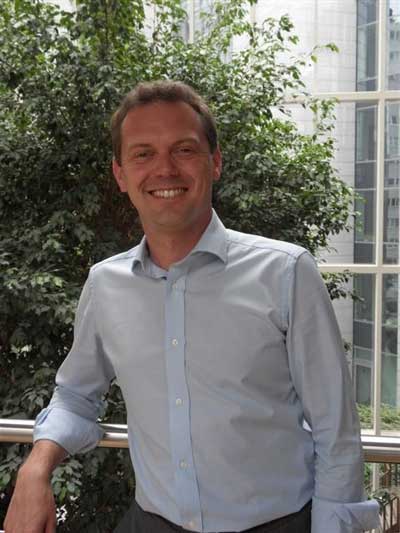- ON THE DECADE
- THE DECADE'S CAMPAIGN
- REPORTING ON PROGRESS
- THE DECADE'S PROGRAMMES
- FOCUS AREAS
-
- Access to sanitation
- Financing water
- Gender and water
- Human right to water
- Integrated Water Resources Management
- Transboundary waters
- Water and cities
- Water and energy
- Water and food security
- Water and sustainable development
- Water and the green economy
- Water cooperation
- Water quality
- Water scarcity
- FOCUS REGIONS
- RESOURCES FOR
- UN e-RESOURCES
2014 UN-Water Annual International Zaragoza Conference. Preparing for World Water Day 2014: Partnerships for improving water and energy access, efficiency and sustainability. 13-16 January 2014
Interviewing Robert Schröder, European Commission
Mr. Schröder is Policy Officer at the European Commission, DG Environment, Unit C.1 Protection of Water Resources and presents the European Innovation Partnership on Water.
 "Water is used in producing energy and the production of it has an effect on the quality and quantity of water. It is therefore important for us to look at both the water and energy policies and ensure the objectives are met".
"Water is used in producing energy and the production of it has an effect on the quality and quantity of water. It is therefore important for us to look at both the water and energy policies and ensure the objectives are met".
What are your expectations on the Zaragoza Conference on partnerships for improving Water and Energy (W&E) access, efficiency and sustainability?
My expectations are to have more knowledge about the current initiatives and developments ongoing when it comes to water and energy. I would like to know what cooperation we can start, to be able to inform them about the EIP initiative and opportunities that can be derived through partnerships since water and energy is one of our main focus of priority.
Why are partnerships for improving Water and Energy (W&E) efficiency, sustainability and accessibility an important theme for the European Commission?
The EU has developed the European Water Policy to ensure the good quality of water supply and quantitative management of water. In line with this policy, there is a strong relationship between water and energy; water is used in producing energy and the production of it has an effect on the quality and quantity of water. It is therefore important for us to look at both the water and energy policies and ensure the objectives are met. In order to achieve these targets, we believe partnerships or collaboration with partners in both the water and energy sectors will help find innovation approach solutions.
What are the main challenges in implementing the European Innovation Partnership on Water (EIP) initiatives among partners to ensure W&E sustainability and efficiency?
The most important challenge is for all the relevant actors to work together in this partnership. It is difficult sometimes to ensure that we get the right people working together so that actors will step out of their usual way of working and collaborate with new partners that they usually do not work with but are important in this area. The second challenge is funding to support these partnerships especially for bigger projects since we do not have direct funds within the EIP Water initiative.
How are governments and industries collaborating to achieve a win-win situation on W&E efficiency, accessibility and sustainability in-line with the EIP on water?
The EIP initiative has Action Groups, which are a voluntary collaboration. As part of the work methods, they are requested to bring together the demand and supply sides of innovations. They have to ensure that they bring together both partners in the industry and public organization and create the needed platform for working together. The EIP Water facilitates the activities of the Action Groups and provides incentives for bringing them together.
What are some of the EIP collaboration approaches the EU is undertaking in order to have more partners share into ideas?
Within the EIP approach there are Action Groups which is one of the main methods of getting partners working together. We also try to promote the EIP initiatives through a communication strategy. In addition we have an “Online Marketplace” where we allow the demand and supply side of innovation to come together and to showcase the activities of the Action Groups. There is also an annual conference where we bring all water and innovation actors together for networking and discussing on water issues.
>> The challenges
>> The focus
>> The themes
>> Objectives and expected results
>> Agenda
>> Conveners and partners
>> Participants
>> Conference daily
>> Opening press release
>> Presentations
>> Closing press release
>> Integrated Energy-Water Planning and Investments
>> Industry partnerships to ensure water and energy efficiency and sustainability
>> Local Partnerships on Water and Energy
>> Policy Research and Innovation Partnerships
>> 14 Jan. World Water Day 2014
>> 14 Jan. Challenges for water and energy in Spain
>> 15 Jan. Side breakfast. Legal and tenure aspects on water and energy
>> 15 Jan. Managing the nexus on water and energy in Spain
>> 15 Jan. World Water Week 2014
>> SAIH
>> Canal Gestión
>> Propelling water with photovoltaic energy
>> Valdespartera Eco-City and Sustainable Town Planning Center
>> Cases on water and energy partnerships
>> Information briefs on Water and Energy
>> Interviewing conference participants
>> Reader on water and energy
>> Video interviews
Copyright | Terms of use | Privacy notice | Site Index | Fraud alert | Help





